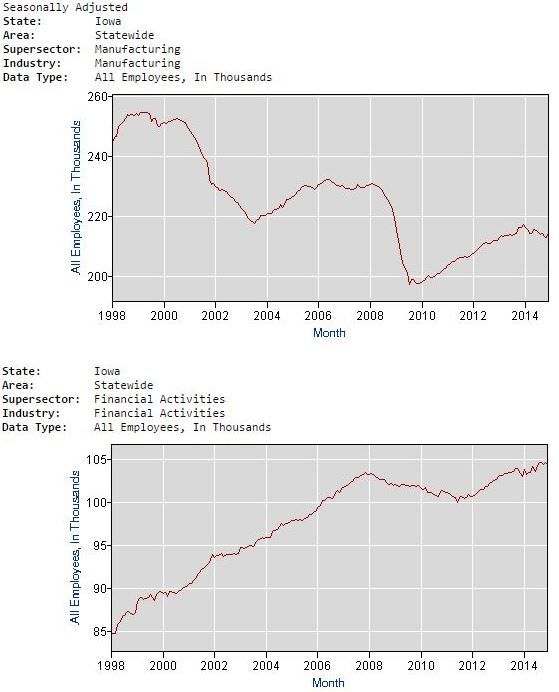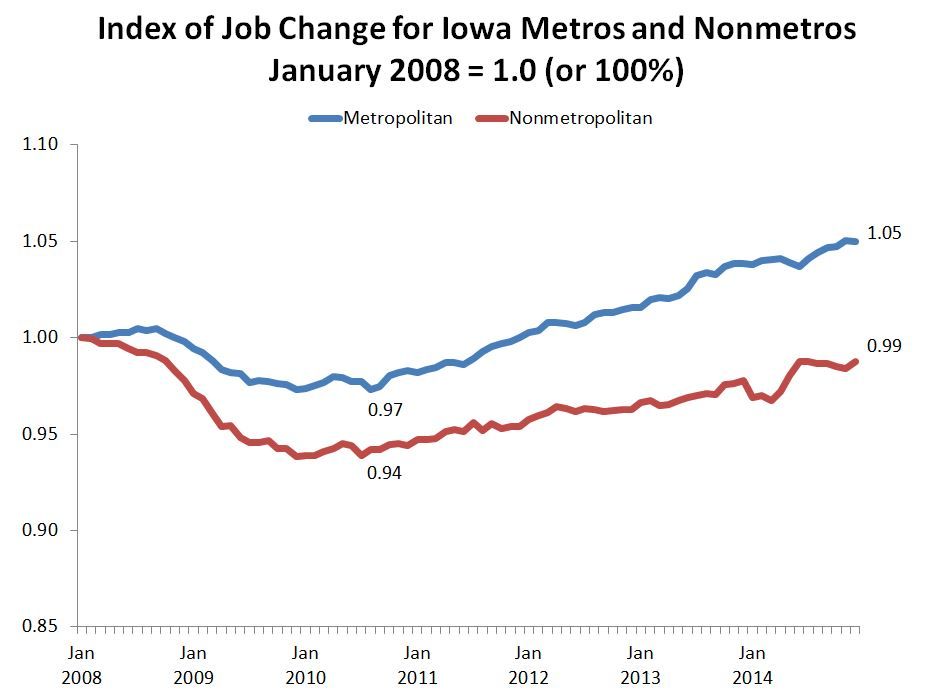Iowa’s manufacturing jobs peaked in 1999 at about 253,000, as is evident in the graph below where the deep dips and partial recoveries represent recessions. Since 1999, the numbers have ratcheted downward. After the 2001 recession, the state leveled off at around 230,000 manufacturing jobs. After the last recession, to include a mini-boom in ag equipment fueled by high crop prices, manufacturing jobs recovered to around 215,000 jobs before tailing off for most of 2014. In contrast, I’ve also posted Iowa’s financial activities (banking and insurance). Those industries grew continuously up to 2008, and dipped through 2011 before growing slowly to new highs.

There are three points to this contrast: firstly, financial activities in Iowa do not go through the same employment swings as modern manufacturing. Second, that industry is on a mostly upward trajectory. And third, and this is what is important, the two graphs exemplify what is happening in urban and rural Iowa. Banking and finance jobs along with most other growing sectors of the Iowa economy are concentrated in metropolitan parts of Iowa. Manufacturing jobs, on the other hand are more numerous and important in nonmetropolitan areas, where they represent 14.5 percent of all jobs as compared to 8.5 percent in metro areas.
Much of the worst effects of the last recession were felt in Iowa’s nonmetropolitan areas, places like Mason City, Muscatine, Fort Dodge, and Keokuk, to just name a few. These are manufacturing dependent urban areas, they went into recession sooner, they dipped farther, and they recovered much more slowly. This is exemplified in the next graphic. The nation slipped into recession at the end of 2007. Iowa’s metropolitan economy declined by 3 percent before recovering to where it closed out 2014 with 5 percent more jobs than when the recession began. Nonmetropolitan Iowa jobs, however, declined by 6 percent, and they closed out 2014 still lower than when the recession began.

The geography of Iowa’s recovery is stark. Most net growth in population in the state is clustered around its metropolitan powerhouses, while continuous declines are widely distributed across nonmetropolitan counties and communities.
The problems of rural decline and struggle are many faceted. Rural economies depend heavily on manufacturing and agriculture, but both industries aggressively shed labor in favor of technology. That labor must migrate to regional trade centers or the metropolitan areas to be productively employed, and the entire process creates a young-adult and skill-migrating spiral as fewer and fewer meaningful earnings opportunities remain in many rural areas over the years.
These are problems that are masked quite well by the metropolitan economies’ better overall performances. Their numbers provide cover for the fact our rural areas are not doing well, they have not been for a long while, and from what I can tell, there is really not much going on at the state level that systematically addresses rural recovery and long term stability.
